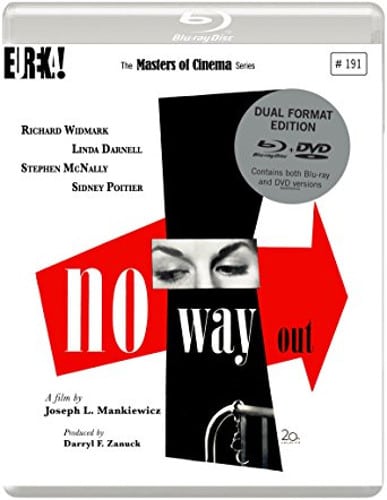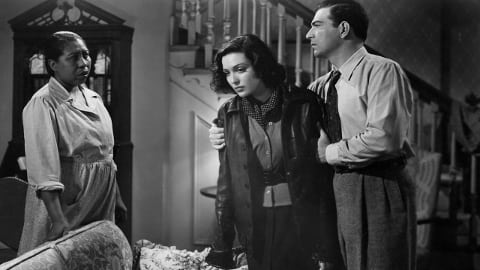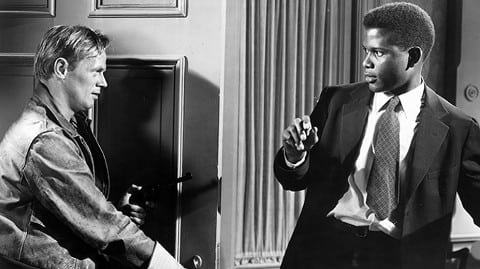No Way Out (1950)
Directed by: Joseph L. Mankiewicz
Written by: Joseph L. Mankiewicz, Lesser Samuels
Starring: Linda Darnell, Richard Widmark, Sidney Poitier, Stephen McNally
USA
AVAILABLE ON DUAL FORMAT BLU-RAY AND DVD: NOW, from EUREKA ENTERTAINMENT
RUNNING TIME: 106 mins
REVIEWED BY: Dr Lenera, Official HCF Critic
Dr. Luther Brooks is the first African-American doctor at the urban county hospital at which he trained. Johnny and Ray Biddle, brothers who were both shot in the leg by a policeman as they attempted a robbery, are brought to the hospital’s prison ward, but racist Ray refuses to be treated by Luther. Then Johnny dies when Luther, thinking he had a brain tumour, administers him a spinal tap. Feeling that he must prove the accuracy of his diagnosis, Luther requests an autopsy, but Ray refuses to let his brother’s body to be cut up and, blaming Luther for Johnny’s death, vows to take revenge on not just him but the whole local black community.…
Older films that attempt to deal with social issues, especially racism, can come across as condescending, naive or even unintentionally offensive to modern eyes. This generally isn’t the case with No Way Out, though considering the amount of racial slurs Richard Widmark’s character utters including around 40 uses of the “n*****” word, I doubt that the script could be filmed now exactly as written. The Twitter snow flake mob would probably be up in arms. In any case though, No Way Out has a tough, angry edge to it that some viewers may find quite surprising and that helps it to hold up very well today, while it’s still certainly very relevant, though it curiously seems to suggest that racism is more of a class-related issue then something institutionalised. I guess it was just felt that film goers weren’t quite ready for the latter. There are a couple of cases of rather simplistic characterisation, and writer/director Joseph L. Mankiewicz’s love of words means that at least two major happenings occur off screen, but the film’s increasing reliance on melodrama certainly didn’t bother this critic – after all, this film is a film noir-tinged drama/thriller with a message rather than a full-on preach-a-thon.
Lesser Samuels’ original story was bid on by Warner Brothers, Paramount, Columbia and Universal-International in addition to Fox, which finally won it. Otto Preminger, Sol C. Siegel and Nunnally Johnson all wanted to produce it, but studio head Darryl F. Zanuck chose to produce it personally. He begged Mankiewicz to write the screenplay, though an uncredited Philip Yordan made some changes while it was Zanuck who ordered the originally very downbeat ending to be altered into one a bit happier. Anne Baxter was originally intended to play Edie Johnson the lead female character, while this was a fourth billed Sidney Poitier’s feature film debut. At his audition he told Mankiewicz he was 27 years old when in fact he was only 22. Widmark often apologised to Poitier after takes in which he had to utter nasty remarks to him. Rather ironically though, the black actors who were part of the race riot scene found out that they were getting paid less than their white equivalents and protested until accommodations were made, while Amanda Randolph who played Gladys the housekeeper wasn’t even credited despite her not inconsiderable amount of screen time. O well, it was 1950 and Hollywood was still in essence a casually racist town. Released the same year as Mankiewicz’s All About Eve, it was the latter that got more attention though No Way Out still got much praise. Perhaps unsurprisingly, it wasn’t shown in some Southern states.
I guess it would have nice to have seen the incident that brings the Biddle brothers to Dr. Luther Brooks, but never mind. Luther has just passed the state board examination to qualify for his license to practice, but because he lacks self-confidence, he requests to work as a junior resident at the hospital for another year. Then another doctor reports sick, and Luther is sent in his place. Almost immediately the man is subjected to abuse from Ray Biddle, who breathes cigarette smoke on him and even hits him while he’s trying to examine him as well as continually saying racist comments. Poitier is already excellent as he shows how the remarks hurt yet still tries to remain calm and do his job. But it’s Widmark who really steals the show performance-wise in what could be the best out of his many very fine exercises in screen villainy. Often he’s genuinely terrifying, and has you thinking that he’s going to lash out at any moment – and this film doesn’t hold back from showing him do that several times. But behind the veneer of hatred, Biddle is also a deeply insecure, misguided and pitiful man and, while never exactly sympathetic, you know that Ray truly believes what he says and does love his brother – though actually he also has another brother George who may be deaf and dumb [and who’s referred as a “dummy” several times – again, just keep remembered this was 1950] but is just as deadly.
Johnny Biddle dies in Luther’s care, and Ray’s convinced that he killed him. He won’t allow an autopsy to prove Luther’s innocence, and the hospital head, aware that a scandal over the black doctor’s actions could endanger funding, denies the request in the hope that the incident will be forgotten. We’re kept guessing for some time whether Luther caused the death or not, and also kept guessing as to what side Edie, a woman trying to escape a dodgy past and attain it seems a slightly higher social status, will end up. She was married to Johnny but had an affair with Ray who now wants her to help get together a load of thugs to attack the black area of town – but Luther and his mentor Dr. Daniel Wharton want her to talk some sense into Ray. Linda Darnell’s performance is another fine one in this film even though her character is a little simplistic and maybe not entirely thought through. Much care has been taken elsewhere though, especially in terms of getting the viewer to think. Soon, a black gang has been put together and our sympathies are certainly with them, in fact we pretty much want them to succeed in their attack upon the whites, some of whom are shown as despicable creatures. “You wanna try it baby, you wannna hurt a n*****” says one to Edie as he pretends to whip someone with a chain. “Take that, black boy” he screams, and the sense of hatred is terrifying. Yet, as soon as the attack begins on these scum, Mankiewicz does something very clever – he cuts to a [white] woman screaming – and immediately the attacking blacks are put in more of a negative light too. Their behaviour is also ugly and probably won’t set things right. Far less of the African-Americans in this movie are portrayed as saints then would probably be the case if this film was made today.
After this some thriller cliches come to the fore and I would really have liked to see one of Luther’s mor extreme actions rather than just hear about it, but Mankiewicz stages two very fine suspense sequences that Alfred Hitchcock would have been proud of, and his film never really loses its power even if it’s possible to say that it slightly fudges the racial aspect in saying that Ray’s hatred of black people is because he saw so many of them move up in the world while he was left at the bottom. I’m sure that class jealousy of this kind did and still does cause hatred of other races, but it seems too easy to explain a character like Ray. But then class is almost as prevalent a theme here as race, and is often presented quite subtly. For example, you have Daniel who’s presented as a progressive person who wants to hire increasing numbers of black doctors, yet he clearly looks down his nose at the white working class Edie and the area which she hails from – and Edie knows this – though I wondered if the two were going to get together at one point [Fortunately they don’t]. No Way Out is very good at adding multiple dimensions to a scene. Another case in point is when Edie, who has some racist tendencies of her own, eventually becomes friendly with Gladys over breakfast. On one level it’s your typical bonding scene in which the former racist is transformed into someone more tolerant, but on another level it’s about women struggling to survive in a violent world ruled by men as each mentions an alcoholic, violent relative, yet talks about it as it’s natural. Just before that Gladys tells Edie that in her free time she likes to invite friends and cook elaborate meals for them, saying: “I like doing it, and it makes me feel I am somebody”. Far better than a load of speechifying.
There’s not as much of the film noir-type lighting as I expected, though a few shots linger in the mind, like a kidnapping staged mainly in darkness with a torch illuminating the center of the screen akin to us watching a non-anamorphic DVD on an anamorphic DVD player. Alfred Newman’s score, often set to the backing of a slow, steady drum beat, is full of brooding tension and shows a different, darker side to this composer to what we tend to be familiar with. No Way Out is, bar a few issues that are perhaps understandable given when it was made, a rather overlooked film that deserves more attention today – confrontational and raw yet also intelligent and still really rather important.
No Way Out is presented on Blu-ray with Eureka’s usual careful restoration that has the clarity and sharpness you want but remains decidedly film-like with plenty of grain. First up among the special features is a commentary that was on the Fox DVD by film noir expert Eddie Muller, who provides a very laid back – with lots of gaps – talk track that’s still full of good observations and interesting facts, from saying how some of the scenes depicting Luther’s home life seem a bit false and poorly written [I don’t mind them myself] to explaining why the climax was relocated from outside to inside. He amusingly but perceptively describes Darnell as “the slatterly sister of Gene Tierney”. Not a commentary to listen to when you’re very tired, but worth hearing nonetheless. Eureka’s main new addition is a nearly two hour documentary from 1983 in which Mankiewizc is interviewed chiefly in his house, but sometimes whilst walking outside and even in Berlin. It’s almost a lost art, documentaries like this which don’t bombard you with images or chop up the chat so impatient viewers won’t get bored. With only a few film stills and no clips, the focus is entirely on Mankiewizc as he answers questions about his career. He provides fascinating insights into how Old Hollywood worked and tells plenty of stories, my favourite being the one about the obviously quite mad Joseph Von Sternberg which I shall leave for you to hear. I had no idea that Mankiewizc was hired to recut Fritz Lang’s Fury and seems to have turned it into the classic that it is. Gold dust for old movie fans. The news reels from the DVD are fun too.
Definitely worth a purchase, even if you don’t “do” really old movies – you may be surprised by it.
DETAILS
*1080p presentation of the film on Blu-ray, with a progressive encode on the DVD
*LPCM mono soundtrack (Uncompressed on the Blu-ray)
*Optional English subtitles
*Audio Commentary by film noir historian Eddie Muller
*All About Mankiewizc – A massive two-part interview with the legendary director, featuring Michael Ciment and directed by Luc Béraud
*Archival Fox Movietone Newsreels
*Original theatrical trailer
*A collector’s booklet featuring a new essay by Glenn Kenny










Be the first to comment